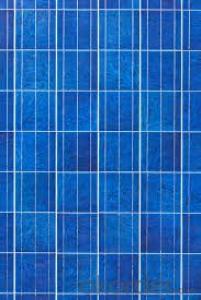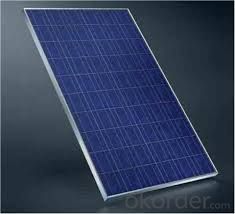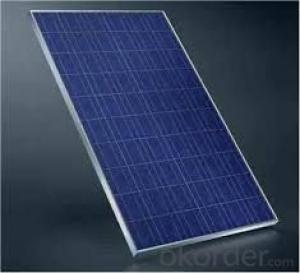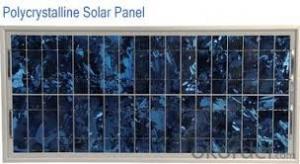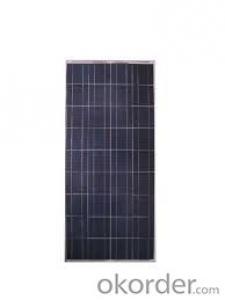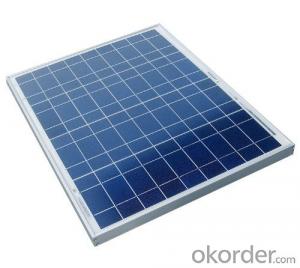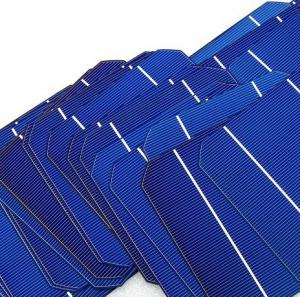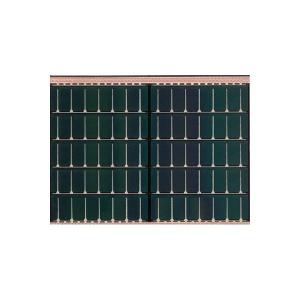4.0 Solar Cells Mini 0.45w Poly Solar Panel with 25 Years Warranty CNBM
- Loading Port:
- Qingdao
- Payment Terms:
- TT OR LC
- Min Order Qty:
- 10 set
- Supply Capability:
- 300000 set/month
OKorder Service Pledge
OKorder Financial Service
You Might Also Like
Polycrystalline Solar Modules
CNBM offers a range of small, medium and large polycrystalline solar modules, designed for a range of requirements.
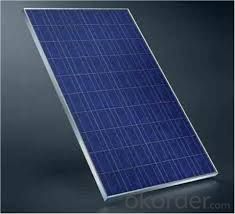
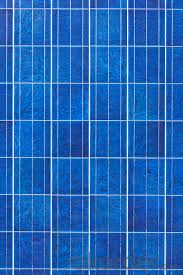
Specifications:
Tolerance | +/-3% |
Cell | Polycrystalline silicon solar cells (156 x 156mm) |
N0. of Cells | 60 (10 x 6) |
Dimension of Modules (mm) | 1650 x 990 x 40 |
Weight (kg) | 25.5 |
Limits:
Operating Temperature | -40~+85? |
Storage Temperature | -40~+85? |
Maximum System Voltage | 1000 VDC max. |
Hail Impact | Diameter of 28mm with impact speed |
Temperature and Coefficients:
NOCT | 48C+/-2? |
Voltage temperature coefficient (%/K) | -0.35 |
Current temperature coefficient (%/K) | 0.05 |
Power temperature coefficient (%/K) | -0.45 |
Characteristics:
Model: | SGM-200P | SGM-210P | SGM-220P |
Max-power voltage Vmp (V) | 29.2 | 29.4 | 29.41 |
Max-power current Imp (A) | 6.85 | 7.14 | 7.48 |
Open-circuit voltage Voc (V) | 36.5 | 36.69 | 36.9 |
Short-Circuit Current Isc (A) | 7.28 | 7.6 | 7.93 |
Max-power Pm(W) | 200 | 210 | 220 |
Model: | SGM-230P |
Max-power voltage Vmp (V) | 29.8 |
Max-power current Imp (A) | 7.72 |
Open-circuit voltage Voc (V) | 37.31 |
Short-Circuit Current Isc (A) | 8.19 |
Max-power Pm(W) | 230 |
STC: Irradiance 1000W/m2, module temperature 25?, AM-=1.5
Poly Crystalline Solar Panels Specifications Range
Maximum Power (Pm) | Dimension | Weight | Operating Voltage (Vmp) | Operating Current (Imp) | Open Circuit Voltage (Voc) | Short Circuit Current (Isc) |
0.45W | 140x80x10mm | 0.08kg | 3.3V | 150mA | 4.6V | 160mA |
1.0W | 162x140x10mm | 0.16kg | 7.5V | 150mA | 10.3V | 160mA |
4.5W | 269x251x23mm | 0.8kg | 16.5V | 0.27A | 20.5V | 0.3A |
10W | 420.1×268.9×22.6mm | 1.92kg | 17.5V | 0.58A | 20.5V | 0.6A |
20W | 425x502x50mm | 3.0kg | 16.8V | 1.19A | 21.0V | 1.29A |
30W | 593x502x22.6mm | 3.9kg | 16.8V | 1.78A | 21.0V | 1.94A |
40W | 655x537x50mm | 5.75kg | 17.3V | 2.31A | 22.1V | 2.54A |
50W | 839x537x50mm | 6.0kg | 17.5V | 2.9A | 21.8V | 3.17A |
65W | 1111x502x50mm | 7.2kg | 17.6V | 3.69A | 22.1V | 3.99A |
80W | 1204x537x50mm | 7.7kg | 17.6V | 4.55A | 22.1V | 4.8A |
- Q: Can solar cells be used for powering electric water heaters?
- Yes, solar cells can be used to power electric water heaters. By converting sunlight into electricity, solar cells can provide a sustainable and renewable source of energy to heat water in electric water heaters. This helps reduce reliance on traditional grid electricity and lowers carbon emissions.
- Q: How do solar cells handle bird droppings or other debris?
- Solar cells are designed to handle bird droppings or other debris by having a smooth and easy-to-clean surface. Additionally, regular rainfall or maintenance can help wash away any accumulated dirt or waste, ensuring optimal performance of the solar cells.
- Q: What is the impact of maintenance and cleaning on solar cell performance?
- Maintenance and cleaning play a crucial role in maintaining optimal solar cell performance. Regular maintenance, such as inspecting and repairing any damages, ensures that the cells are functioning efficiently and effectively. Additionally, cleaning the solar panels helps remove any dirt, dust, or debris that can accumulate and hinder sunlight absorption. By keeping the panels clean and well-maintained, solar cell performance is maximized, resulting in higher energy production and increased overall efficiency.
- Q: Can solar cells be used in powering medical devices?
- Yes, solar cells can be used in powering medical devices. Solar cells convert sunlight into electricity, which can then be used to power various medical devices such as portable diagnostic tools, wearable health monitors, or even small medical implants. This technology offers a sustainable and reliable energy source, particularly in areas with limited access to electricity or during emergencies where traditional power sources may not be available.
- Q: How does the solar panel produce it yourself?
- ?The third step: the production of counter-electrode batteries need positive electrode, of course, also need anti-electrode. Positive electrode and counter electrode, is made of conductive SnO2 film layer composition, the use of a simple multimeter to determine the side of the glass can be conductive, the use of fingers can also make judgments, the conductive surface is more rough. The non-conductive surface marked with '+', and then use a pencil on the conductive surface evenly coated with a layer of graphite.
- Q: What is the typical lifespan of a solar cell?
- The typical lifespan of a solar cell is around 25 to 30 years, although some high-quality solar panels can last up to 40 years with proper maintenance and care.
- Q: Can solar cells be used in off-grid water desalination?
- Yes, solar cells can be used in off-grid water desalination. Solar energy can be harnessed to power the desalination process, providing a sustainable and renewable energy source for converting seawater into fresh water in off-grid locations. This allows for the production of clean drinking water without the need for a traditional electricity grid.
- Q: How do solar cells affect the local ecosystem?
- Solar cells have a minimal impact on the local ecosystem. Unlike traditional energy sources, solar cells do not produce harmful emissions or pollution during their operation. Additionally, solar farms can be designed to coexist with the natural environment by incorporating measures like landscaping and wildlife-friendly habitats. Overall, solar cells contribute positively to the local ecosystem by promoting clean energy and reducing carbon emissions.
- Q: How do solar cells impact global warming?
- Solar cells have a positive impact on global warming as they generate electricity using sunlight, a renewable energy source, without emitting greenhouse gases. By reducing the reliance on fossil fuels, solar cells help mitigate climate change and decrease carbon emissions, thus slowing down the progression of global warming.
- Q: Can solar cells be used to power water pumps or irrigation systems?
- Yes, solar cells can be used to power water pumps or irrigation systems. Solar panels can convert sunlight into electricity, which can then be used to power water pumps or irrigation systems. This is a sustainable and environmentally friendly solution as it relies on renewable energy sources.
Send your message to us
4.0 Solar Cells Mini 0.45w Poly Solar Panel with 25 Years Warranty CNBM
- Loading Port:
- Qingdao
- Payment Terms:
- TT OR LC
- Min Order Qty:
- 10 set
- Supply Capability:
- 300000 set/month
OKorder Service Pledge
OKorder Financial Service
Similar products
Hot products
Hot Searches
Related keywords
